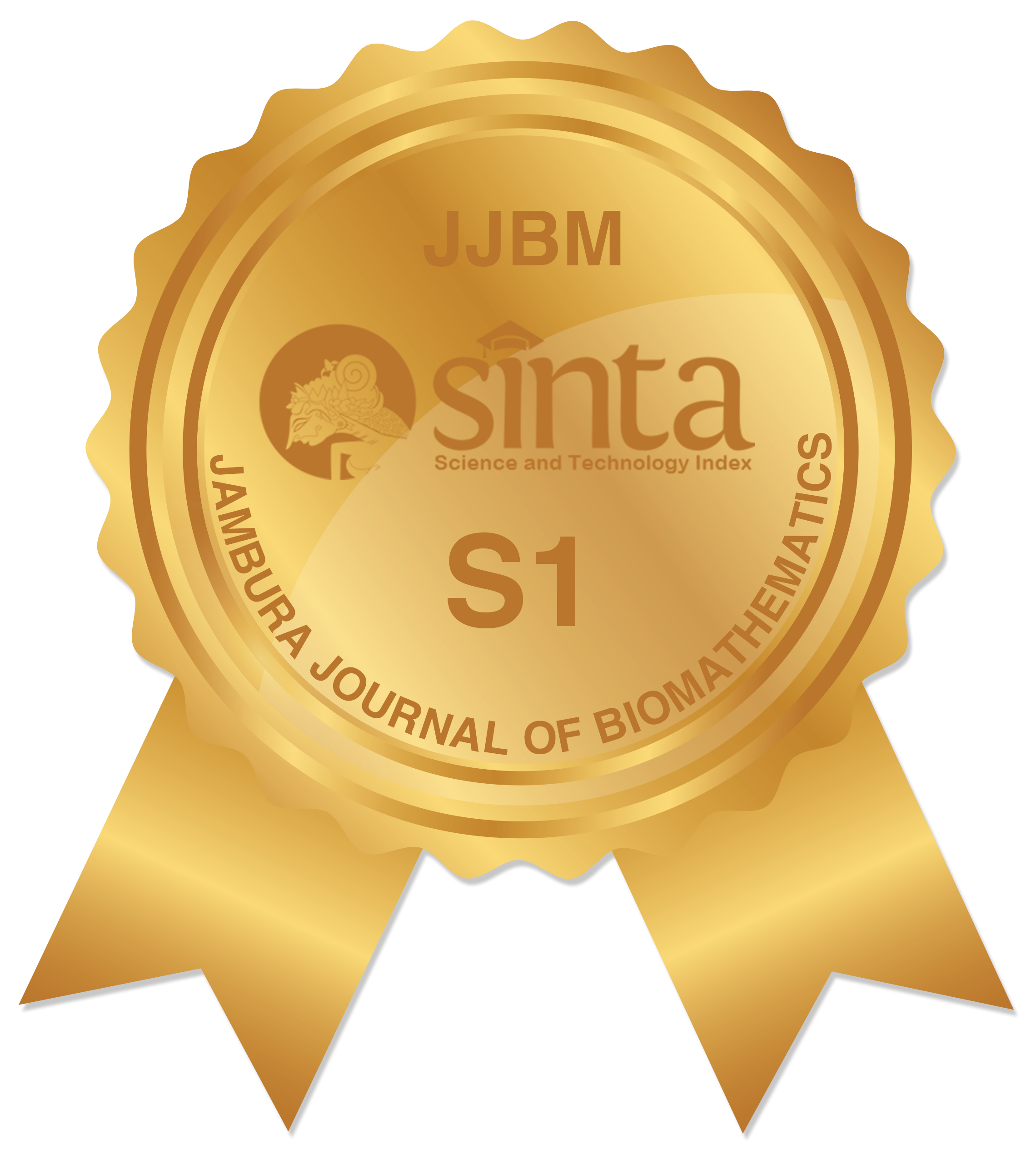Dynamics System in the SEIR-SI Model of the Spread of Malaria with Recurrence
Abstract
Keywords
Full Text:
PDFReferences
E. Aprianti, J. Jaharuddin, and E. H. Nugrahani, "The effect of susceptible immigrants in a system dynamic on the spread of malaria in Indonesia" JTAM (Jurnal Teori dan Aplikasi Matematika), vol. 6, no. 3, pp. 777-788, 2022. DOI: 10.31764/jtam.v6i3.8630
E. Setyaningrum, Mengenal Malaria dan Vektornya. AliImron Pustaka Keluarga Pilihan, 2020.
N. Rahayu, S. Sulasmi, and Y. Suryatinah, "Identifikasi spesies plasmodium malaria menurut karakteristik masyarakat desa temunih provinsi kalimantan selatan" SPIRAKEL, vol. 9, no. 1, pp. 10-18, 2017. DOI: 10.22435/spirakel.v8i2.6747
N. Rasita et al., "Identifikasi bentuk tropozoit untuk menentukan jenis parasit penderita malaria yang datang berobat di puskesmas perawatan lawe sumur kota cane aceh tenggara" Ph.D. dissertation, Universitas Medan Area, 2019.
A. A. Arsin, "Malaria di indonesia tinjauan aspek epidemiologi" Penerbit: Masagena Press. IKAPI, 2012.
N. Hamidah, U. D. Purwati et al., "Analisis model matematika penyebaran koinfeksi malaria-tifus." Departemen Matematika Fakultas Sains dan Teknologi, Universitas Airlangga, pp. 87-96, 2017
W. H. Organization, World malaria report 2021. World Health Organization, 2021.
Kemenkes RI, "Profil kesehatan indonesia 2020" Kementrian Kesehatan Republik Indonesia., 2021.
E. M. Banni, M. A. Kleden, M. Lobo, and M. Z. Ndii, "Estimasi Reproduction Number Model Matematika Penyebaran Malaria di Sumba Tengah, Indonesia" Jambura Journal of Biomathematics (JJBM), vol. 2, no. 1, pp. 13-19, 2021. DOI: 10.34312/jjbm.v2i1.9971
G. Ngwa and W. Shu, "A mathematical model for endemic malaria with variable human and mosquito populations" Mathematical and Computer Modelling, vol. 32, no. 7-8, pp. 747-763, oct 2000. DOI: 10.1016/S0895-7177(00)00169-2
M. Osman, I. Adu, and C. Yang, "A Simple SEIR Mathematical Model of Malaria Transmission" Asian Research Journal of Mathematics, vol. 7, no. 3, pp. 1-22, 2017. DOI: 10.9734/ARJOM/2017/37471
N. Budhwar and S. Daniel, "Stability analysis of a human-mosquito model of malaria with infective immigrants" International Journal of Mathematical and Computational Sciences, vol. 11, no. 2, pp. 85-89, 2017.
M. A. Baihaqi and F. Adi-Kusumo, "Modelling malaria transmission in a population with SEIRSp method" AIP Conference Proceedings, vol. 2264, no. 1, 09 2020, 020002. DOI: 10.1063/5.0023508
L. Edelstein-Keshet, Mathematical Models in Biology, ser. Classics in Applied Mathematics. Society for Industrial and Applied Mathematics (SIAM, 3600 Market Street, Floor 6, Philadelphia, PA 19104), 1988. ISBN 9780898719147.
C. Castillo-Chavez and B. Song, "Dynamical Models of Tuberculosis and Their Applications" Mathematical Biosciences and Engineering, vol. 1, no. 2, pp. 361-404, 2004. DOI: 10.3934/mbe.2004.1.361
R. Resmawan, "Efektifitas Vaksinasi dan Pengasapan pada Model Epidemik Transmisi Penyakit Malaria" Jambura Journal of Mathematics, vol. 1, no. 1, pp. 25-35, jan 2019. DOI: 10.34312/jjom.v1i1.2004
T. R. I. Putra, "Malaria dan permasalahannya" Jurnal Kedokteran Syiah Kuala, vol. 11, no. 2, pp. 103-114, 2011.
S. Sillehu and T. N. Utami, "Pengenalan diagnosis malaria." Forum Ilmiah Kesehatan (FORIKES), 2018.
DOI: https://doi.org/10.34312/jjbm.v4i1.18754
Copyright (c) 2023 Afdhal Ahkrizal, Jaharuddin, and Endar H. Nugrahani

This work is licensed under a Creative Commons Attribution-NonCommercial 4.0 International License.
Jambura Journal of Biomathematics (JJBM) has been indexed by:
EDITORIAL OFFICE OF JAMBURA JOURNAL OF BIOMATHEMATICS |
 | Department of Mathematics, Faculty of Mathematics and Natural Science, Universitas Negeri Gorontalo Jl. Prof. Dr. Ing. B. J. Habibie, Moutong, Tilongkabila, Kabupaten Bone Bolango 96554, Gorontalo, Indonesia |
 | Email: [email protected] |
 | +6281356190818 (WA Only) |
 | Jambura Journal of Biomathematics (JJBM) by Department of Mathematics Universitas Negeri Gorontalo is licensed under a Creative Commons Attribution-NonCommercial 4.0 International License. Powered by Public Knowledge Project OJS. |















